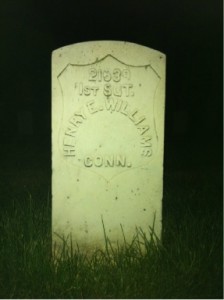What do the 17th Connecticut and the National Weather Service have in common?
Henry Eugene Williams.
Who?
Henry Williams was an 18-year-old teacher living in Bethel, CT when he enlisted as H. Eugene Williams in Company C of the 17th in July 1862 and mustered in as Corporal. Williams served throughout the war with the 17th, rising to the rank of 1st Lieutenant (although not mustered in as such) by the time he mustered out with the regiment 3 years later. Williams was captured at Chancellorsville. By the end of the war he often found himself in command of Company C while still a 1st Sergeant.
Following the end of the war, Williams stayed in uniform, enlisting in the Regular Army and remaining there until 1876. After leaving the Army, Williams enlisted in the US Army Signal Corps, where he was assigned to the new “Division of Telegrams and Reports for the Benefit of Commerce.” The mandate of the division, as stated by a Joint Resolution of Congress, was “…to provide for taking meteorological observations at the military stations in the interior of the continent and at other points in the States and Territories…and for giving notice on the northern (Great) lakes and on the seacoast by magnetic telegraph and marine signals, of the approach and force of storms.”
As related in a summary of his career published by the War Department’s Office of the Chief Signal Officer upon Williams’ 1920 retirement, “…the greater portion of Mr. Williams’s tour of duty in the meteorological service was spent in the Forecast Division of the central office in Washington. While not himself a forecaster, being chiefly concerned with administrative matters in connection with the division, he had the unique experience of a close up view of the forecasting activities of the Army Signal Corps and the civilian organization the United States Weather Bureau that succeeded it in 1891. He was assistant chief of the Weather Bureau from July 1, 1903 to June 30, 1912.” This included a stint as an instructor at Fort Myer (then known as Fort Whipple and now known as Joint Base Myer-Henderson Hall) during the 1880s, where Williams became well-known for the grey mule he commuted from Georgetown on each day.
Williams wrote a history of the Weather Bureau in 1916, as well as another volume titled “Temperatures Injurious to Food Products in Storage and During Transportation, and Methods of Protection from the Same” in 1896.
All told, Williams spent a combined 52 years and 4 months in military and civil service, 44 of which were spent in the Weather Service. He died on March 28, 1930 and is buried in Arlington National Cemetery, Section 17, Grave 21639 – very near old Fort Myer, where he spent so many years in the service of his country. His gravestone carries his last confirmed rank from his Civil War service with the 17th CVI more than 60 years earlier.

